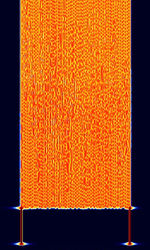MT63
MT63 is an Orthogonal Frequency Division Multiplexed (OFDMOrthogonal Frequency-Division Multiplexing) digital data mode aimed for use in high noise environments. MT63 was developed by Paweł Jałocha SP9VRC. MT63 is designed for keyboard-to-keyboard conversation modes on HFHigh Frequency (3-30 MHz) amateur radio bands.
MT63 distributes the encoding of each character over a long time period and over several tones. This code and symbol spreading implementation is key to its robustness under less than ideal conditions. The MT63 mode is very tolerant of mistuning, as most software will handle 120 HzHertz (Hz), unit of frequency, defined as one cycle per second (1 Hz). tuning offsets under normal conditions.[1]
MT63 uses 64 BPSKBinary Phase-Shift Keying (1 bit per symbol) (2-PSKBinary Phase-Shift Keying (1 bit per symbol)) channels placed in 500, 1000, and 2000Hz of bandwidth.
There are 2 main modes of transmission: Short Interleaving and Long Interleaving. With Short Interleaving, MT63's robustness is somewhat compromised in exchange for lower latency (Time to end of transmission). With Long Interleaving, MT63 operates at its best robustness in exchange for a longer latency (about double the latency of Short Interleaving).
Samples[edit]
| Short Interleaving | Long Interleaving |
|---|---|
| |
|
| |
|
| |
|
Decoding Software[edit]
- Hobby Level Software
- fldigi
- MT63 Terminal
- AndFLMsg for Android Devices
- TIVAR Android fork of FLDigi
- Professional Software














